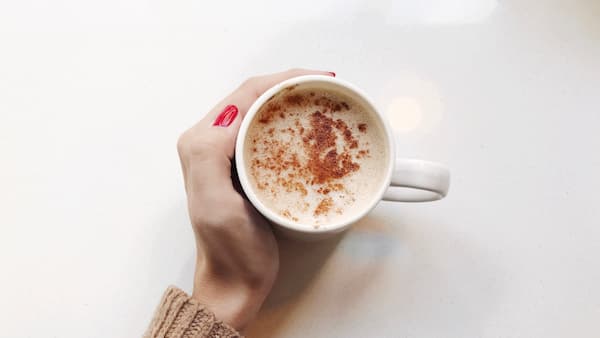How many calories in coffee?
I get it. You love coffee. You love it so much that you worry if you keep gulping it down, it’ll eventually hit your waist, pushing you onboard a weight loss steam train that you’re not excited thinking about. Wait. No. That’s me, sorry. But wait, maybe it’s you too!
Anyway, if you’ve wondered how many calories there are in coffee, keep reading.

How Many Calories In Black Coffee?
For coffee lovers who prefer their brew black and who are on a strict diet, there’s good news: black coffee has so few calories per cup that it’s very nearly calorie-free.
According to the USDA, one standard serving of black coffee has only 2 calories, where the standard serving is 100 grams (g) or 100 milliliters(ml).
With it being so low, all while giving you that caffeine-derived energy boost, tasting great (with the right beans), and yielding a whole host of potential health benefits, black coffee is the understated champion brew in my opinion.
Why Black Coffee Contains Little Calories
So why are the calories in coffee taken black so low? One reason is that brewed coffee on its own with nothing added to it is mostly water.
If you think about it, that makes sense: coffee is mostly water, after all. The coffee beans themselves aren’t typically left in the cup unless you’ve brewed using an old-school immersion method, like Turkish coffee.
Even then, the amount of coffee grounds present is low, and you’ll likely try to avoid gulping them down. Right?
In fact, only 1.25% of the brew in your cup of coffee is coffee beans. But the liquid itself is mostly water, too–it’s the sugar that makes it high in calories.

More generally, coffee beans are tough and hard, so a large amount of the plant matter that makes it into your cup of coffee is just good old fiber. Then of course, there’s the caffeine and the polyphenols and other enzymes and compounds. Because we don’t tend to digest fiber all that well, it’s not a good source of calories.
Between that and the fact that there’s not much plant matter in the cup anyway, brewed coffee on its own just can’t have that many calories in it.
Of course, we mentioned water before, and that brings us to the next point: while black coffee only has 2 calories, the different things we add to coffee all stack up, as each is essentially a high-calorie addition.
The way you make your coffee can also play a role, as well as the size of the cup. Adding 2 teaspoons of sugar to your coffee brings it up to 34 calories, while just 2 ounces of reduced-fat milk adds 30.
A quick reference from public health information, based on 2-ounce serving:
- Cream: 206 calories
- Half & half: 74 calories
- Whole milk: 38 calories
- 2% milk: 30 calories
- Skim milk: 22 calories
- Unsweetened almond: 10 calories
- Unsweetened soy: 10 calories
And of course, the calorie counts go up the more products you add to your energy boost and the more calorific those products are.
How Many Calories In Coffee: Milky Espresso Drinks
If your coffee drink of choice is the americano, you don’t have much to worry about, since an espresso shot is only about 3 calories, and the average Starbucks americano is only about 5 calories.
But once you start looking at lattes and other dairy-based drinks, the calorie content starts racking up pretty quickly.
For the sake of consistency, we’re using Starbucks (yup, I know it isn’t great but we need a set of figures to compare) as the reference point and the “Tall” (12 oz) size. Let’s take a look at the calorie counts, based mostly on the information and nutrition data on their site:
- Latte: 150 calories
- This is without any syrups or added sugar, just espresso and milk.
- Mocha: 230 calories (no whip version)
- With whip, the tall mocha comes to 290 calories.
- Caramel Macchiato: 190 calories
- Includes espresso, vanilla syrup, steamed milk, and caramel sauce
- Cappuccino: 100 calories
- Since the cappuccino has more foam and less steamed milk, the calories are lower.
- Breve: 246 calories
- Breve refers to half & half, with a higher fat content than milk.
It’s clear then that the type of coffee drinks you choose has a significant bearing on the calorie content. Coffee drinks with lots of milk or cream and sugar in them will have a higher number of calories than those that just have brewed coffee.
How To Reduce Calories In Coffee
If you’re worried about your health and calorie intake or on a diet, then there are a few different ways you can cut some calories from your cups of coffee. These include:
- Switching to plant-based milk
- Avoiding sugar-based additions (including syrups)
- Starting to drink your coffee black!
As discussed, your cup of coffee starts out at between 2 and 5 calories, and from there, you have a number of options for keeping the calories low.
If you prefer milky coffees, consider switching to an unsweetened, non-dairy option. Almond and oat milks are good choices, with only 10 calories for almond and about 15 for oat.
If you’re not interested in non-dairy options, switch to fat-free milk–at 22 calories for 2 ounces, it’s still a significant decrease compared to whole or 2%.
At the end of the day, if you’re trying to lose weight or worried about maintaining hard-earned weight loss, the general consensus is to reduce calorie intake beyond your metabolic rate, aka the rate you burn calories.
When it comes to your cups of coffee, you can do this by switching to natural no-calorie sweeteners instead of using sugar. Stevia is one option that many coffee lovers swear by, and monk fruit is another that people love.
Try A Lighter Roast Bean
A final thing to consider is cutting out the additional products altogether. By choosing a higher quality coffee and a lighter roast, you will likely find that you don’t miss the dairy or sugar.
Lighter roasts are naturally higher in acids, which given the coffee bean flavor—leading to more naturally sweeter flavors, often reminiscent of a fruity tea. If you ask me, an Ethiopian single origin roasted lightly is the best way to enjoy coffee black!

